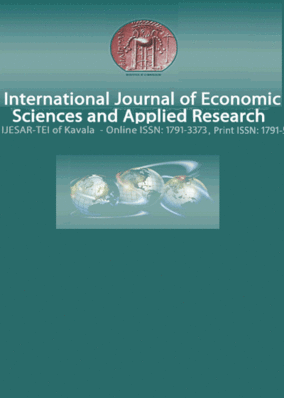A partial equilibrium analysis of NAFTA ’s impact on U.S. bilateral trade
Part of : International journal of economic sciences and applied research ; Vol.7, No.1, 2014, pages 89-112
Issue:
Pages:
89-112
Author:
Abstract:
This paper examines the effects of the North American Free Trade Agreement on agricultural commodity trade using extensive data. The data cover agricultural exports and imports between the U.S. and NAFTA partners over the extended period of 1989-2010. The commodities covered in the analyses include; corn, soy bean, cotton, wheat, fresh vegetables, poultry, dairy products, and red meats. A partial equilibrium model, in which we derive each trading partner s excess demand and excess supply, is used to study the impact of NAFTA on trade, controlling for other trade-inducing variables such as exchange rates, tariffs, per capita incomes, and relative prices. Regression results show mixed effects of NAFTA on different commodities while graphical and counterfactual analyses indicate strictly positive effects.
Subject (LC):
Keywords:
AFTA, agricultural commodity trade, partial equilibrium analysis
Notes:
Περιέχει εικόνες, πίνακες και βιβλιογραφία
References (1):
- Botric, V., 2013, Determinants of Intra-industry Trade between Western Balkans and EU-15:Evidence from Bilateral Data, International Journal of Economic Sciences andAppliedResearch, 6, 2, pp. 7-23.Boylan,T., Cuddy, M. and O’Muircheartaigh, I., 1980, ‘The Functional Form of theAggregate Import Demand Equation: A Comparison of Three European Economies ’,Journal of International Economics, 10, 4, pp. 561-566.Burfisher, M.E. and Jones, E.A. (eds.), 1998, ‘Regional Trade Agreements and U.S.Agriculture’, Market and Trade Economics Division, Economic Research Service, U.S.Department of Agriculture, Agricultural Information Bulletin No. 745.Burfisher, M.E., Robinson, S. and Thierfelder. K., 2001, ‘The Impact of NAFTA on theUnited States Journal of Economic Perspectives, 15, 1, pp. 125-144.Davey, W.J., 2005, ‘Regional Trade Agreements and the WTO: General Observationsand NAFTA Lessons for Asia’, Illinois Public Law and Legal Theory Research PaperSeries, Research Paper No. 05-18.Dickey, D.A. and Fuller, W.A., 1979, ‘Distributions of the Estimators for AutoregressiveTime Series with a Unit Root’, Journal of the American Statistical Association, 74, pp.427-431.Dickey, D.A. and Fuller, W.A., 1981, ‘Likelihood ratio statistics for autoregressive timeseries with a unit root’, Econometrica, 49, pp. 1057-1072.Doroodian, K., Koshal, R.K. and Al-Muhanna S., 1994, ‘An Examination of the TraditionalAggregate Import Demand Function for Saudi Arabia’, Applied Economics, 26, 9, pp.909-915.Enders, W., 2004, Applied Econometric Time Series, 2nd ed. John Wiley & Sons Inc., pp.171.ERS (Economic Research Service of the USDA), 1999. ‘NAFTA: The Record to Date’,World Agriculture and Trade, Agricultural Outlook, September, 1999.Granger, C. and Newbold, R, 1974, ‘Spurious Regressions in Econometrics ’, Journal ofEconometrics, 2, pp. 111-120.Hejazi, W. and Safarian, A.E., 2005, ‘NAFTA Effects and the Level of Development’,Journal of Business Research, 58, 12, pp. 1741-1749.Hillberry, R.H. and McDaniel, C.A., 2002, ‘A Decomposition of North American TradeGrowth since NAFTA’, International Trade Commission.Office of Economics WorkingPaper, No. 2002-12-A.Hinojosa-Ojeda, R., Runsten, D., De Paolis, F. and Kamel, N., 2000, ‘The U.S. EmploymentImpacts of North American Integration after NAFTA: A Partial Equilibrium Approach’,Unpublished manuscript, North American Integration and Development Center, Schoolof Public Policy and Social Research, UCLA.Hummels, D. and Klenow, P.J., 2002, ‘The Variety and Quality of a Nation’s Trade’,National Bureau of Economic Research (NBER) Working Paper 8712.Khan, M.S. & Ross, K., 1977, ‘The Functional form of the Aggregate Import DemandEquation’, Journal of International Economics, 7, 2, pp. 149-160.Koo, W.W. and Kennedy, P.L., 2005, International Trade and Agriculture, BlackwellPublishing.Matchaya, G. C., Chilonda, P. and Nhelengethwa, S., 2013, ‘International Trade andIncome in Malawi: A Co-integration and Causality Approach’, International Journal ofEconomic Sciences and Applied Research, 6, 2, pp. 125-147.McDaniel, C.A. and Agama, L-A., 2003, ‘The NAFTA Preference and U.S. - Mexico Trade:Aggregate-Level Analysis ’, The World Economy, 26, 7, pp. 939-955.OECD (Organization for Economic Co-operation and Development), 2001, ‘RegionalIntegration: Observed Trade and other Economic Effects ’, OECD Doc, TD/TC/WP(2001)19/Final.Oyinlola, M. A., Adeniyi, O. and Omisakin, O., 2010, Responsiveness of Trade Flows toChanges in Exchange rate and Relative prices: Evidence from Nigeria, InternationalJournal of Economic Sciences and Applied Research, 3, 2, pp. 123-141.USDA (U.S. Department of Agriculture), 1997, NAFTA. WRS-97-2, Washington, DC.USDA-FAS (Foreign Agricultural Service of the U.S. Department of Agriculture), 2012,Global Agricultural Trade System (GATS Database), http://www.fas.usda.gov/gats/default.aspx.Viner, J., 1950,The Customs Union Issue, New York, Carnegie Endowment for InternationalPeace.Zahniser, S. and Link, J. (eds.), 2002, ‘Effects of North American Free Trade Agreementon Agriculture and the Rural Economy ’, A Report from the Economic Research Service,ERS/USDA, WRS (02-01).Zahniser, S. and Roe A. (eds.), 2011, ‘NAFTA at 17: Full Implementation leads to IncreasedTrade and Integration ’, A Report from the Economic Research Service, ERS/USDA,WRS (11-01).




